


|

|
![]()
Just as there are some confusion over the genealogy of King Arthur, so there are with House of the Grail Hero.
Again, I have divided this page into two broad categories those of sources of the early traditions and that of the later tradition, depending on the various texts and their heroes.
The early tradition is where the main hero is Perceval; texts that were before the Vulgate Cycle (pre-1227) was written.
The later tradition of course relied on the Vulgate Cycle and the Post-Vulgate Cycle, where the Grail legend has a new hero, Galahad. The English writer, Sir Thomas Malory had relied on the later tradition for his Le Morte d'Arthure. Despite Galahad being the main hero, I have included the genealogy of Perceval, where he has a different family members.
| Early Tradition | ||
| Later Tradition |
| House of Perceval (Chretien de Troyes' version) | ||
| House of Perceval (Robert de Boron's version) | ||
|
House of Perlesvaus (from Le Haut Livre du Graal or Perlesvaus) |
||
| House of Parzival (Wolfram von Eschenbach's version) |
House of Perceval (Chretien de Troyes' version)
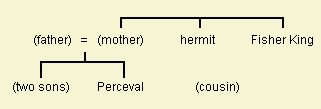
|
This is family of Perceval, according to the first story of the Grail, written by Chretien de Troyes, called Conte du Graal or Perceval (1185). The Fisher King was his uncle, as well as the hermit. The only other people who in his family was the mother and his cousin. No name was given to any of the family members. It alluded to that Perceval's father and two older brothers were killed, possibly before or shortly after he was born. In the 2nd Continuation and the Gerbert de Montreuil Continuation (4th Continuation), Perceval has a sister. Chretien's work doesn't mention any sister, except a foster-sister, who was actually his cousin. See Conte du Graal about Perceval. |
House of Perceval (Robert de Boron's version)
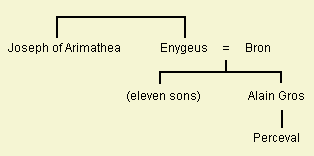
|
According to the French poet, Robert de Boron, who wrote the Grail trilogy (Joseph d'Arimathie, Merlin and Perceval), Perceval and the Fisher King (Alain le Gros) were related to Joseph of Arimathea, a disciple of Jesus Christ. Perceval's grandfather was named Bron, the Rich Fisher, who had brought the Grail to Britain. Perceval's father was given a name Alain de Gros, the Fisher King. Alain was the youngest of twelve brothers. Note that in the Didot Perceval or Prose Perceval, Bron was the Fisher King, and that he was ill, not maimed. Also, there were no indication that Perceval have any brother in this version. Notice that in the other Grail romances, it is on his mother's side that Perceval was related to the Fisher King (eg. his maternal uncle), but not here and in the Didot Perceval, where he was of direct line of the Fisher King on his father's side. See Didot Perceval for the story of Perceval, and Origin of the Grail for the legend of Joseph of Arimathea. |
House of Perlesvaus (from Le Haut Livre du Graal or Perlesvaus)

|
The genealogy above was obtained from the Le Haut Livre du Graal (High History of the Grail), which was also known as Perlesvaus (c. 1210), where Perlesvaus is another name for Perceval. The monks of Glastonbury had probably written Perlesvaus. Glastonbury used to be an island in a middle of a marsh. Some have identified Glastonbury Tor to be Avalon and the place where Arthur was buried with Guinevere. Here, Perceval's parents were Alain le Gros and Yglais. Yglais belonged to the lineage of Joseph of Arimathea, while Alain belonged to that of Nicodemus, who had aided Joseph of Arimathea in covering Jesus' body in the shroud. (Read 19.38-42 from the Gospel of John of the New Testament.) Here, we have the Fisher King who is a different person to Pelles, the King of the Lower Folk; both of them are the brothers of Yglais and uncles of Perceval. Some legends combined Pelles and the Fisher King into one person, like in the Vulgate and Post-Vulgate cycles, as well as in Sir Thomas Malory's Le Morte d'Arthur. Like Boron's version, Alain had eleven brothers, but in Perlesvaus, he was the eldest son of Gais le Gros. None of Alain's brothers lived beyond twelve years after being knighted, each one killed in either battle or adventure. Since there are too many brothers to list them in the family tree, their names are given below: Gorgalians, Bruns Brandnils, Bertholez 1i Chauz, Brandalus of Wales, Elinant of Escavalon, Calobrutus, Meralis of the Palace Meadow, Fortunes of the Red Launde, Melaarmaus of Abanie, Galians of the White Tower, and Alibans of the Waste City. In most of tales about Perceval, his mother died in grief because he left her to become a knight. In the Perlesvaus, it is different. Perceval's father had died, while his mother lived on throughout most of Perceval's adventure. Perceval's father and uncles were all buried in a tomb, on an island of unspecified location. |
House of Parzival (Wolfram von Eschenbach's version)
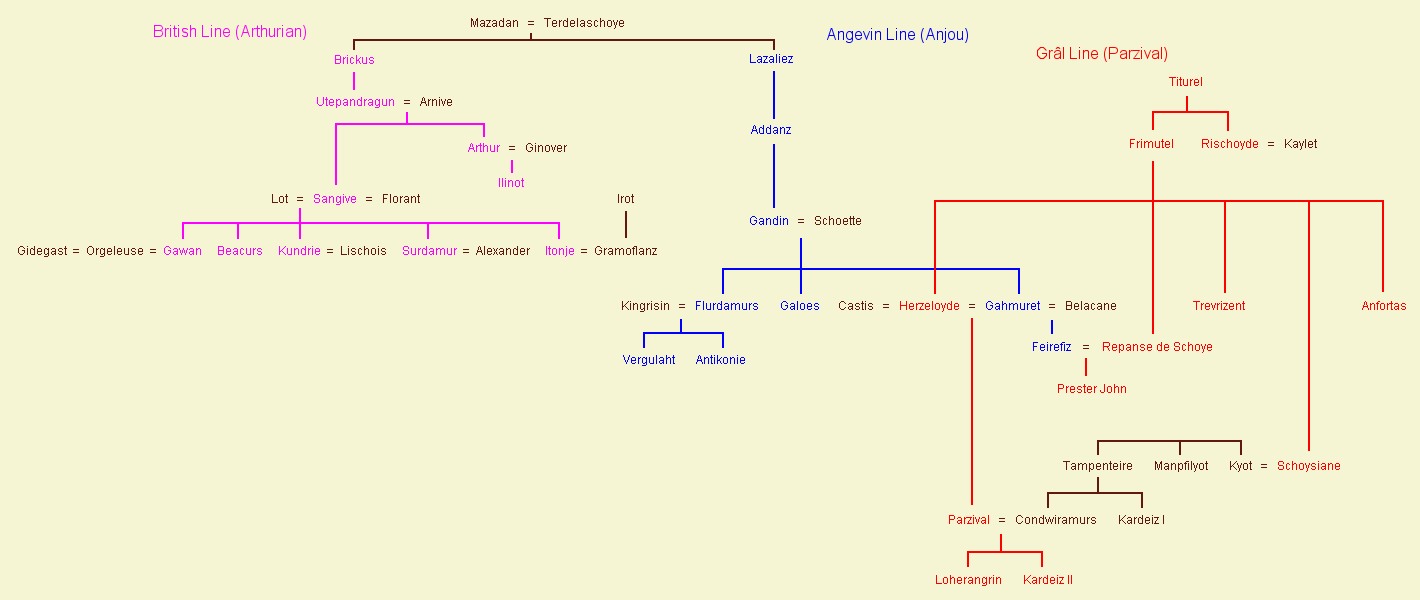
|
Parzival is a great German masterpiece of Wolfram von Eschenbach, written in about 1210. Parzival is not so much a translation of Chretien de Troyes' Perceval; rather it is a recreation of something new. Note that apart from Arthur and Lot, many of the names has being altered, such as Perceval has changed to Parzival, Gawain to Gawan, Guinevere to Ginover, Sangive is Arthur's sister, etc. Anfortas is the Grail King. Even the name Grail has being changed to "Gral" or "Grâl". |
The information from the following family trees was obtained using sources from the tales of the Vulgate Cycle and Post Vulgate Cycle.
| House of Pellinor | ||
|
House of Lancelot and the Fisher King |
House of Pellinore (Vulgate / Post-Vulgate version)

|
According to the Vulgate Cycle and Post-Vulgate Cycle, a new hero emerged as hero of the Grail quest, displacing the original hero, Perceval. The family tree of Perceval shown here, where Perceval is no longer related to the Fisher King like the early tradition. Perceval was now seen as the son of King Pellinor. The Fisher King or Grail Keeper was now related to family of Lancelot, particularly to Galahad. See House of Lancelot and the Fisher King. See Quest of the Holy Grail (Galahad's tradition). |
House of Lancelot and the Fisher King
When the Vulgate romances was written, the Grail legend had a new hero – Galahad. Galahad replaced the earlier hero, Perceval, and the content took on more spiritual meaning, with more Christian motifs and symbolism than ever before. Not only did we have a new hero, but all the adventures were also different. (See Early Tradition, for the family trees of Perceval.)
Note also that Perceval was no longer related to Fisher King or Grail Keeper. Perceval was now the son of King Pellinor. See the previous family tree, titled the House of Pellinor.
There are two different versions of the genealogy of Lancelot and the Grail Keeper: Vulgate and Post-Vulgate.
See Quest of the Holy Grail (Galahad's tradition) for the story about Galahad.
Vulgate version:
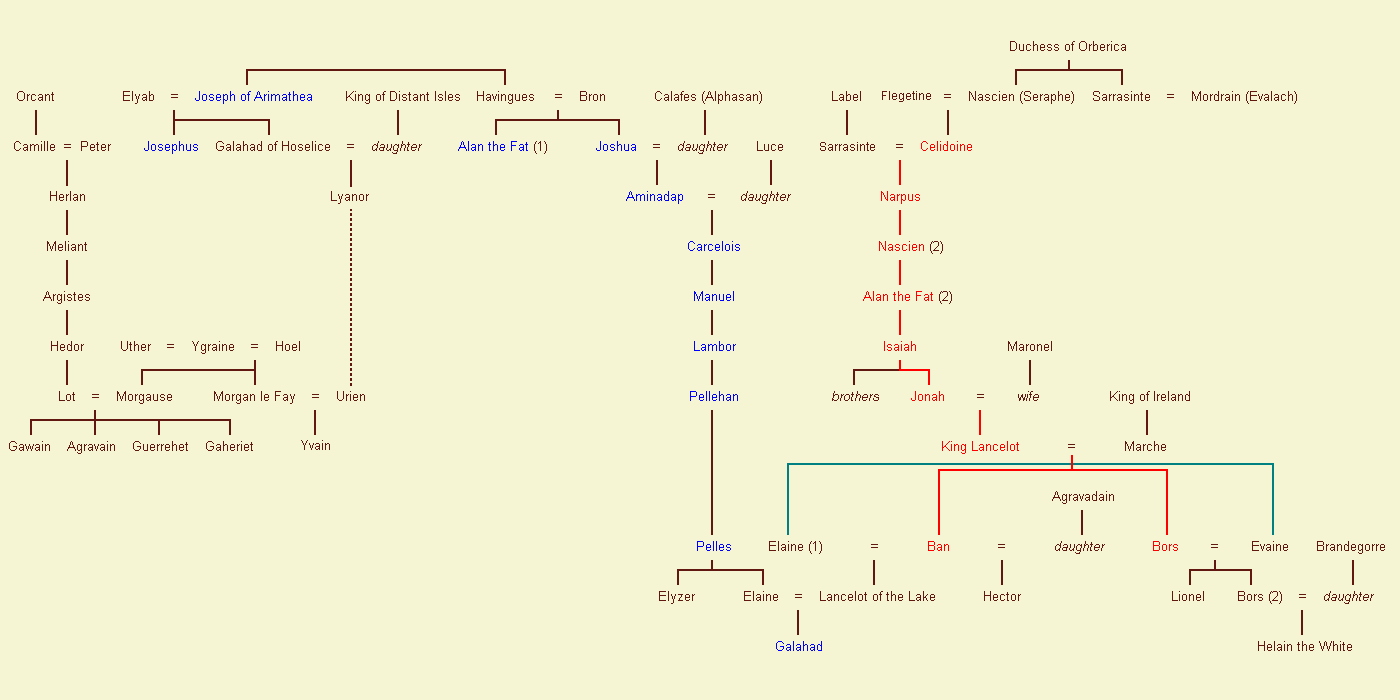
|
The main sources of the Vulgate genealogy, come from the Vulgate romances: The History of the Grail, Merlin, Lancelot and Quest of the Holy Grail. This family tree provided a more detail than the Post-Vulgate family tree. I have fully listed all the ancestors of Lancelot and the House of Grail Keeper, all the way to the time of Joseph of Arimathea. (Well, as full as can get. The legend claimed that Lancelot and Galahad are descendants of King David, but no medieval writers gave a list of names that go back that far in time. Lancelot was descendant of King David on his mother's side.) On Lancelot's side, the Grail legend begin with his ancestor, Nascien (or Seraphe, his Saracen name). While the line of King Pelles goes back all the way to the sister of Joseph of Arimathea. As to the line of Joseph himself, he can claim descendants like King Urien and his son, Yvain. Nascien was contemporary of Joseph. Both lines can be found in the Vulgate work called The History of the Grail. The house of Joseph of Arimathea can be found in chapters 38 and 40. While the lineage of Nascien can be found in the last chapter, 41. Other Vulgate works (such as Merlin, Lancelot and the Quest) help me supplement other names that can't be found in History. It should be noted that some names appeared twice in the family tree. There are two Nascien, two of Alan the Fat, and two of Lancelot. The hero Lancelot of the Lake should be distinguished from his grandfather, King Lancelot. Also, there are actually three Galahads. When Lancelot of the Lake was born, his name was actually Galahad. Galahad is also the name of Lancelot's son, the true Grail hero. Another Galahad was a king of Hoselice (old name for Wales), and he was also the son of Joseph of Arimathea. This Galahad of Hoselice was an ancestor of King Urien of Gorre and his son Yvain. Unfortunately, we only know of Galahad's son Lysanor; the rest of Galahad-Urien line doesn't mention other names. There also two Elaines. One Elaine is the mother of Lancelot and wife of King Ban. Lancelot's mother was known as the Queen of Great Sorrow, because she lost her husband and son on the same day. The other Elaine, became was the daughter of King Pelles. She was the Grail maiden, who became Lancelot's lover and the mother of the hero Galahad. Josephus, son of Joseph of Arimathea, was purely an invention of the Vulgate writers, because he doesn't appear in the early tradition. Previous tales (Perceval's tradition), say that it was Alain (Alan the Fat), son of Bron, was the ancestor of the Grail family, but in the Vulgate legend, the Grail king was descendant of Joshua, one of Alain's brothers. The Grail story continued to say that Galahad was the last of Nascien's noble line, but I think that they have forgotten Helain the White, the son of the hero Bors, who was also of Nascien's lineage. Helain became the Emperor of Constantiople, but there are no legend about this (....well as far as I can tell). For the sake of completion, I have included the lineage of Lot and Gawain. They were a direct descendants of Peter, a kinsman of Joseph and Josephus. It is uncertain whether Peter was a cousin or nephew of Josephus. |
Post-Vulgate version:
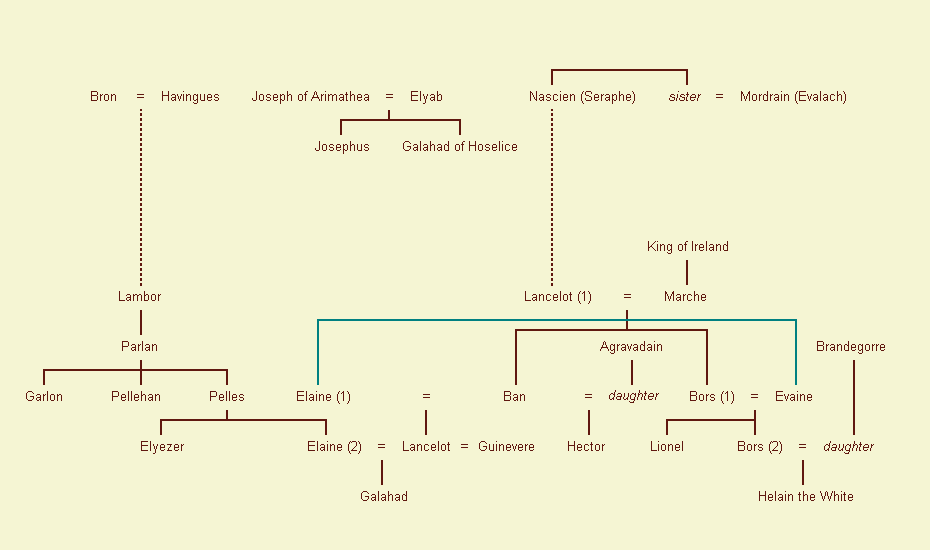
|
The Post-Vulgate genealogy provided less detail than the Vulgate family tree. This family tree can also be used with Sir Thomas Malory's Arthurian romance: Le Morte d'Arthur. The main difference you will notice is that the Post-Vulgate tree showed Pellehan is King Pelles's brother, not father, as in the Vulgate Cycle. Pelles' father is Parlan in the Post-Vulgate, but in the English Le Morte d'Arthur it is Pellam. Also, the Post-Vulgate doesn't show all the ancestors of King Pelles and Lancelot. |
This page belongs to Timeless Myths.
See Copyright Notices for permitted use.
For feedback, questions, or just to say "hello",
contact can made through the Contact page.
No mailing list or spamming, please.
Home | Arthurian Legends | Camelot | Age of Chivalry | Songs of Deeds
What's New? | Bibliography | Fact & Figures | Genealogy | FAQs | Copyright | Links | Donation | Contact | Back
Copyright: Timeless Myths (Arthurian Legends) © 1999, Jimmy Joe. All rights reserved.
First Created (Genealogy: Houses of the Grail Keeper and the Grail Hero): 01/03/2001.
Last Modified: 24/06/06.